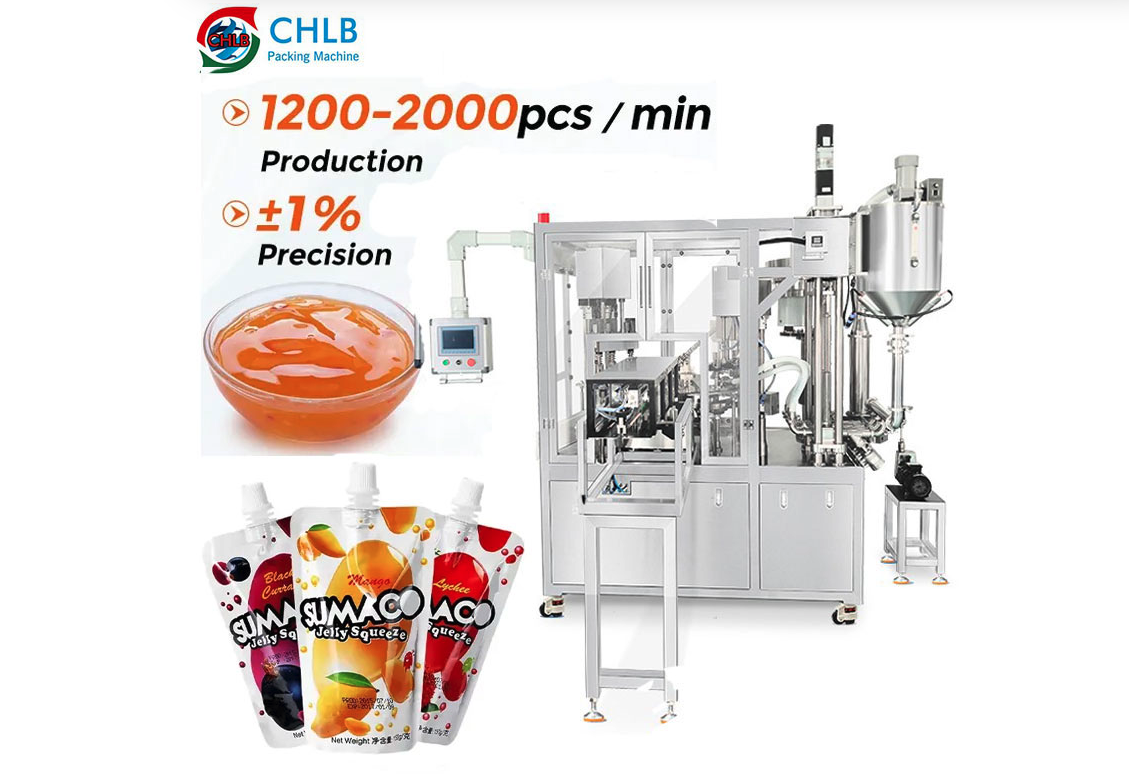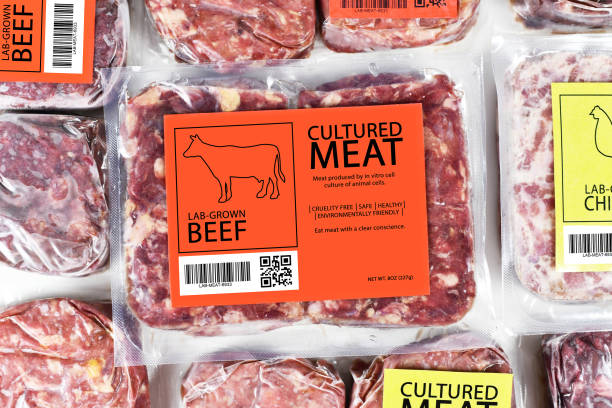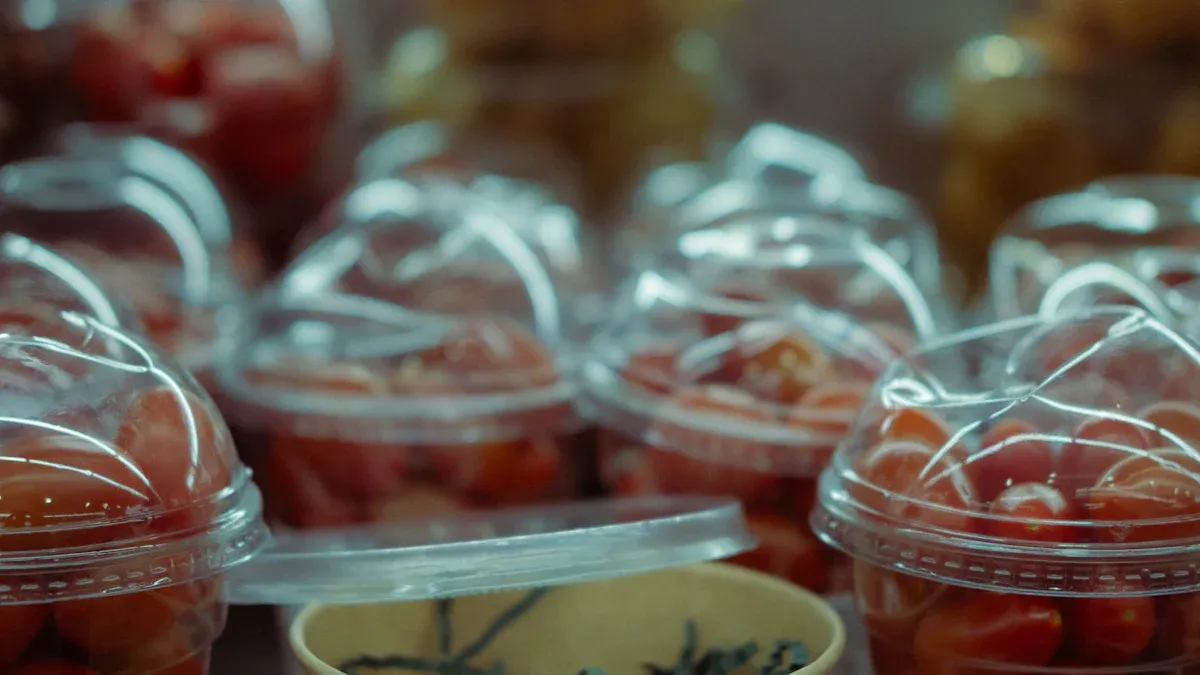
Choosing the right frozen food packaging materials is very important. They keep food safe and help it stay fresh and tasty. These materials protect frozen food from temperature changes and germs. Eco-friendly packaging is also becoming more popular. People want options that are better for the planet. New designs, like resealable bags, help save food and money. Picking the right frozen food packaging materials can improve food quality and help the environment.
Wichtige Erkenntnisse
Picking good frozen food packaging helps keep food fresh and clean.
Plastic is cheap and bendable, but it harms the environment since it’s not recycled much.
Glass is good for the planet and keeps food fresh, but it breaks easily and is heavy to move.
Biodegradable materials help the earth but aren’t as tough as regular plastic.
Think about food type, kosten, and the environment when choosing packaging.
Frozen Food Packaging Materials
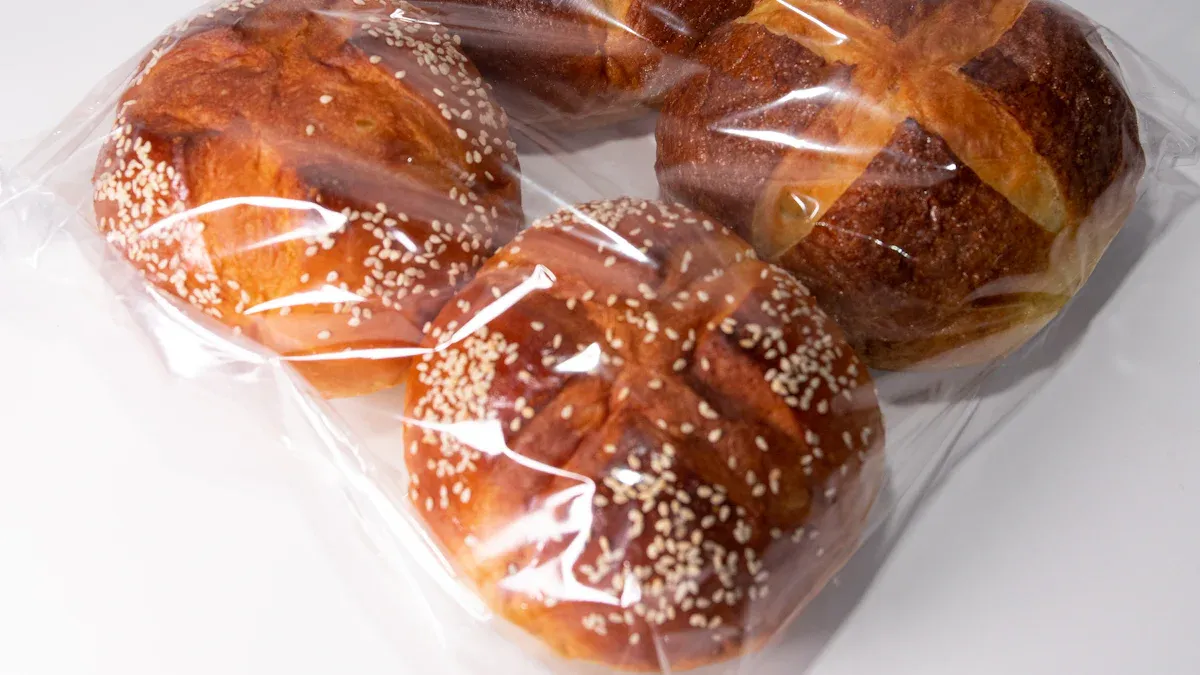
Plastik
Plastic is a very popular material for frozen food packaging. It is leicht, strong, and affordable. You can find it as bags, Wraps, or containers. Plastic seals easily, keeping food fresh and safe from germs. It blocks moisture, Fett, und Öl, making it great for frozen food. It also stays flexible in cold temperatures, protecting your food.
Different plastics have unique uses. Zum Beispiel:
Type of Plastic | Merkmale | Verwendung |
|---|---|---|
Strong barrier, dauerhaft | Common for frozen food packaging | |
Polypropylen (PP) | Heat-resistant, bendable | Used in wraps and films |
Polyvinylchlorid (PVC) | Seals well | Found in cling wraps |
Polyethylenterephthalat (HAUSTIER) | Lightweight, sturdy | Helps keep food fresh |
But plastic has environmental problems. Many plastics don’t break down naturally. If thrown away carelessly, they can hurt nature. Recyclable plastics are better, Die Recyclingraten sind jedoch an vielen Stellen immer noch niedrig.
Glas
Glas ist eine qualitativ hochwertige Wahl für gefrorene Lebensmittelverpackungen. Es reagiert nicht mit Essen, Aromen frisch halten. Glas blockiert auch Feuchtigkeit, Verhindern Sie das Verderben des Essens. Im Gegensatz zu Plastik, Glas kann für immer recycelt werden, ohne Qualität zu verlieren, es umweltfreundlich machen.
Vorteile der Glasverpackung | Nachteile der Glasverpackung |
|---|---|
Reagiert nicht mit Lebensmitteln | Bricht leicht |
Blöcke Feuchtigkeit | Schwer zu transportieren |
Hält Essen frisch | Sperrig für die Lagerung |
Glas hat auch einige Probleme. Es kann brechen, Welches ist unsicher. Das Bewegen und Speichern von Glas ist schwer, weil es schwer ist und Platz einnimmt. Auch, Nur über 33% von Glasabfällen wird recycelt, seine grünen Vorteile einschränken.
Metall
Metall ist ein weiteres wichtiges Material mit gefrorenem Lebensmittelverpackung. Es ist stark, lang anhaltende, und hält Lebensmittel vor Keimen sicher. Metalldosen haben oft spezielle Beschichtungen, um zu verhindern, dass Lebensmittel mit dem Behälter reagieren. Diese Beschichtungen machen auch Dosen für den langfristigen Gebrauch stabiler.
Metall funktioniert gut für bestimmte gefrorene Lebensmittel. Zum Beispiel, Zinkoxidbeschichtungen verhindern, dass Konservenfutter die Farbe verlieren. Aber einige Lebensmittel, wie schwefelreiches Gemüse, kann dazu führen, dass Metall rost. Das Auswahl des richtigen Metalls und der richtigen Beschichtung ist der Schlüssel für die Lebensmittelsicherheit.
Tipp: Wählen Sie Metallverpackungen basierend auf dem Lebensmitteltyp und den Speicheranforderungen für die besten Ergebnisse.
Papier und Karton
Papier und Karton sind üblich für gefrorene Lebensmittelverpackungen. Sie sind leicht und recycelbar, sie einfach zu bedienen machen. Diese Materialien werden oft in Kisten geformt, Wraps, oder Kartons. Gefrorene Pizzen, Gemüse, und Desserts sind normalerweise in ihnen gepackt.
Ein großer Vorteil von Papier und Karton ist ihre Umweltfreundlichkeit. Recycling sie schafft weniger Verschwendung als sie zu verbrennen, die schädliche Chemikalien freigibt. Deponien mit Papier machen herum 10% weniger Abfall als Verbrennung. Deponien können jedoch immer noch Giftstoffe in den Boden auslaufen. Recycling ist die beste Option, da es giftige Nebenprodukte vermeidet.
Es gibt einige Nachteile zu Papier und Pappe. Sie widerstehen nicht gut Feuchtigkeit, Kondensation kann sie also feucht machen. Hersteller fügen Beschichtungen hinzu, um dies zu beheben, Aber Beschichtungen können das Recycling erschweren. Auch, Papier und Karton schützen keine Lebensmittel sowie Plastik oder Metall für lange Lagerung.
Tipp: Wählen Sie Recyclingpapier oder Karton mit weniger Beschichtungen für eine bessere Nachhaltigkeit.
Biologisch abbaubare und zusammengesetzte Materialien
Biologisch abbaubare und Verbundwerkstoffe sind umweltfreundliche Verpackungsmöglichkeiten. Sie brechen natürlich zusammen, Abfall und Verschmutzung schneiden. Auf Biopolymerbasis Verpackung hilft dem Planeten, Ozeane zu schützen und CO2-Fußabdrücke zu senken.
Einige biologisch abbaubare Filme, Wie Cellulose, Fangen Sie an, im Boden in den Boden abzubrechen 8 Tage. Andere, Wie Alginate -Filme, vollständig in Kompost zersetzen danach 14 Tage. Stärkebasierte Filme können sich sogar in Meerwasser auflösen 42 Tage. Diese Merkmale machen sie hervorragend, um den Umweltschaden zu verringern.
Aber biologisch abbaubare Materialien haben einige Probleme. Sie sind nicht so stark oder feuchtigkeitsresistent wie Plastik. Sie können auch mehr kosten, Dies könnte die Preise für Käufer erhöhen.
🌍 Wussten Sie? Lebensmittelverpackung macht es gut 9% aus Plastikmüll von Ozean. Das Umschalten auf biologisch abbaubare Materialien kann dazu beitragen, die Meeresleben zu retten.
Detaillierte Vor- und Nachteile jedes Materials
Plastik
Plastik ist eine häufige Wahl für gefrorene Lebensmittelverpackungen. It is billig, einfach zu bedienen, und kommt in Wraps, Taschen, or containers. Plastik schützt Nahrung vor Luft und Feuchtigkeit. Es ist leicht, Es ist also einfach zu tragen und zu bewegen. Es biegt auch, ohne kalte Temperaturen zu brechen.
Vorteile:
Kostengünstig: Plastic costs less than other materials. This makes it affordable for companies and shoppers.
Durable and Flexible: It stays strong in freezing temperatures and keeps food safe.
Barrier Properties: Special plastic layers block air and moisture. This stops freezer burn.
Bequemlichkeit: Many plastic packages can be resealed. This helps store and reuse food easily.
Nachteile:
Environmental Concerns: Most plastics don’t break down naturally. This causes pollution and waste. Recycling rates are still low in many areas.
Moisture Issues: Wet cartons can collapse and cause losses. Um 20% of losses happen because of this problem.
In some places, advanced plastic packaging makes up 40% of frozen food packaging. But in other areas, it’s only 6%. This shows there’s room to use better plastic solutions.
Glas
Glass is a high-quality option for frozen food packaging. It doesn’t mix with food, so flavors stay fresh. You can see the food inside, which looks nice and is helpful. Glass is eco-friendly because it can be recycled forever without losing quality.
Vorteile:
Non-Reactive: Glass doesn’t change the taste or nutrients of food.
Eco-Friendly: Glass recycling doesn’t lose quality, making it better for the planet.
Moisture Barrier: It keeps moisture out, helping food stay fresh longer.
Nachteile:
Zerbrechlichkeit: Glass can break easily, which is dangerous to handle.
Weight and Bulk: It’s heavy and takes up space, making it harder to store and ship.
Limited Recycling Rates: Only 33% of glass gets recycled, which lowers its green benefits.
Glass is great for fancy frozen foods where looks and quality matter. But its downsides make it less useful for everyday items.
Metall
Metal cans are strong and reliable for frozen food packaging. They protect food from air, Licht, und Feuchtigkeit. Metal cans often have coatings to stop food from reacting with the container. These coatings make cans last longer.
Vorteile:
Haltbarkeit: Metal doesn’t break easily, so it’s good for shipping and storage.
Barrier Properties: It blocks air, Licht, und Feuchtigkeit, keeping food fresh and safe.
Longevity: Metal works well for storing food for a long time, like soups.
Nachteile:
Corrosion Risk: Some foods, wie schwefelreiches Gemüse, can make metal rust if coatings aren’t strong.
Gewicht: Metal is heavier than paper or plastic, which raises shipping costs.
Recycling Challenges: Recycling metal uses a lot of energy, which isn’t great for the environment.
Metal is best for frozen foods that need long storage and strong protection. But its weight and rust issues make it less flexible than other materials.
Papier und Karton
Papier und Karton sind üblich für gefrorene Lebensmittelverpackungen. Sie sind leicht, simple to use, und recycelbar. These materials are often used for boxes, Wraps, oder Kartons. Gefrorene Pizzen, Gemüse, und Desserts sind normalerweise in ihnen gepackt. They are also great for printing logos and product details.
Vorteile:
Eco-Friendly: Paper and cardboard break down naturally and can be recycled. Recycling uses less energy than making new materials.
Lightweight: They are easy to move and store, lowering shipping costs.
Customizable: You can print directly on them, which is good for labels and ads.
Nachteile:
Moisture Sensitivity: They soak up water, which can make them weak. This limits their use for long-term frozen food storage.
Limited Protection: They don’t block air or moisture as well as plastic or metal. This can cause freezer burn or spoilage without proper coatings.
Recycling Challenges: Coatings added for moisture resistance can make recycling harder.
Tipp: Pick paper or cardboard with fewer coatings and recycled content. This helps the environment while keeping the packaging useful.
Paper and cardboard are best for short-term frozen food storage. They work well for foods with less moisture or items eaten soon after buying.
Biologisch abbaubare und zusammengesetzte Materialien
Biodegradable and composite materials are eco-friendly packaging options. Sie brechen natürlich zusammen, Verringerung von Abfall und Verschmutzung. These materials are made from renewable sources like polylactic acid (PLA) or PBAT.
Vorteile:
Environmentally Friendly: They decompose into natural elements, leaving no harmful waste. This lowers the environmental impact of packaging.
Innovative Designs: Biodegradable films can be made for special uses, like wrapping small portions or lining boxes.
Marine Safety: Some films dissolve in seawater, helping protect ocean life from plastic.
Nachteile:
Performance Limitations: They aren’t as strong or water-resistant as regular plastics. This makes them less durable for frozen food.
Higher Costs: Making biodegradable packaging costs more, which can raise food prices.
Degradation Factors: Their breakdown depends on things like temperature and time. Zum Beispiel, PLA films may crack or weaken as they degrade, affecting food safety.
🌱 Wussten Sie? Einige biologisch abbaubare Filme, like alginate ones, start breaking down in 8 Tage. This quick process helps reduce waste faster.
Biodegradable and composite materials are the future of frozen food packaging. They still need improvements in strength and cost. But choosing them helps the planet while keeping food safe.
Key Factors to Consider When Choosing Packaging
Food Type and Shelf Life
When picking frozen food packaging, think about the food type and how long it lasts. Different foods need different packaging to stay fresh. Zum Beispiel, frozen veggies need protection from freezer burn. Frozen desserts need packaging that keeps their flavor and texture. It’s important to think about how the food reacts to changes in look, smell, und Geschmack.
Microbial activity: Some foods grow germs faster, which can make them unsafe. Packaging with strong barriers stops germs from getting in.
Chemical interactions: Some packaging materials can mix with food, causing chemicals to move into it. This can change the food’s quality and safety.
Evidence Description | Key Points |
|---|---|
Sensory Characteristics | Changes in look, smell, schmecken, and texture shorten shelf life. |
Verpackungsmaterialien | Weak packaging lets in air and moisture, ruining food early. |
Environmental Factors | Food type and storage methods affect how long food stays fresh. |
Packaging should handle temperature changes to keep food fresh during shipping and storage. Picking the right materials helps food last longer and stay safe.
Umweltauswirkungen
The effect of packaging on the environment is a big concern now. Many people want eco-friendly packaging that creates less waste and protects nature. You should check how much energy and resources are used to make, use, and throw away the packaging.
Studies show using green energy and efficient machines can lower the environmental harm of packaging. Zum Beispiel, packaged broccoli and grapes have less impact on the environment compared to other foods. This shows why choosing packaging that reduces waste while keeping food fresh is important.
🌍 Tipp: Use biodegradable or recyclable packaging to cut waste and help the planet.
By looking at the full life of the packaging, you can see its total environmental impact. This helps you pick options that are better for the earth while keeping food safe.
Kosteneffektivität
Cost matters when choosing packaging that balances price and quality. Think about both the cost of materials and how they are made.
Material | Cost Range (per unit) | Characteristics |
|---|---|---|
Plastik | Cheap, flexibel, but fancy designs cost more. | |
Cardboard and Paperboard | $0.1 – $0.3 | Affordable and green, but custom designs cost extra. |
Glas | $0.5 – $1.5 | Keeps food fresh but costs more to ship. |
Metall (Aluminium, Stahl) | $0.2 – $1.0 | Strong and long-lasting but expensive to make. |
Plastic is often the cheapest choice because it’s light and easy to ship. Flexible bags and pouches use less material than hard containers, saving money. Multi-layer plastic films also protect food from temperature changes and freezer burn.
💡 Notiz: Glass and metal are strong but cost more. Think about your budget to find the best option.
Choosing cost-effective materials helps save money while keeping food safe and meeting environmental goals.
Consumer Preferences and Convenience
When picking frozen food packaging, people often want it to be easy to use. Packaging that makes life simpler is very important. Studies show convenience affects many frozen food choices. Zum Beispiel:
14% pick frozen foods because they are easy to use.
13% like packaging that makes cooking faster.
14% want packaging for quick meals.
9% enjoy saving time with frozen food.
11% choose packaging that keeps food fresh longer to avoid waste.
Other things, like cost (9%), simple meal planning (8%), schmecken (8%), and variety (6%), also matter to shoppers.
Packaging helps meet these needs. Resealable bags make storing leftovers simple. Clear containers show the food inside, helping with meal planning. Lightweight packaging is easy to carry and store. These features make frozen food packaging more useful for everyday life.
People also want packaging that saves time. Single-serve or pre-portioned meals cut down cooking steps. This makes frozen food great for busy days. Packaging made for microwaves or ovens makes cooking faster and easier. These options fit well with busy lifestyles.
Keeping food fresh is important too. Packaging that stops freezer burn helps food last longer. This reduces waste and saves money. Materials like plastic or metal are good at blocking air and moisture. They keep food safe and fresh.
Am Ende, frozen food packaging should be easy to use, Halten Sie Lebensmittel frisch, and save time. When packaging does all this, it becomes a helpful part of daily life.
Emerging Trends in Frozen Food Packaging
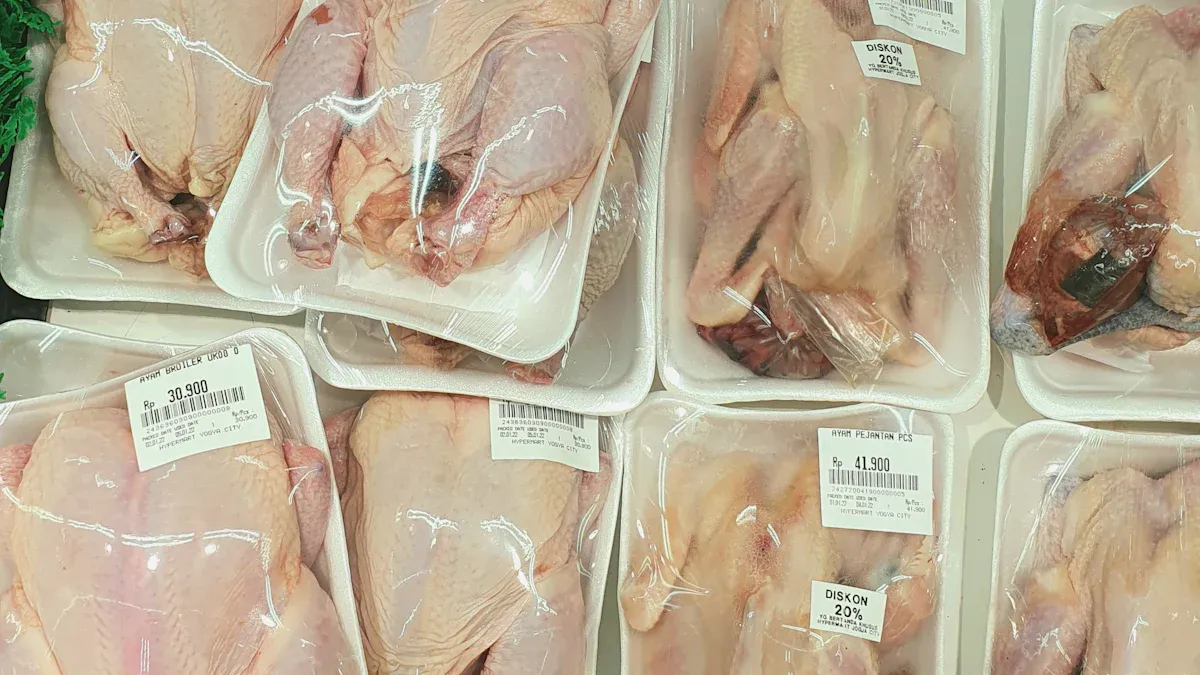
Biologisch abbaubare und kompostierbare Materialien
Biodegradable and compostable materials are changing frozen food packaging. Diese Materialien zerfallen auf natürliche Weise, helping reduce waste and protect nature. Many companies now use eco-friendly materials to meet customer demands. Zum Beispiel, trays made from renewable resources are popular for frozen meals. These trays break down quickly without leaving harmful waste.
Some packaging uses biopolymers like polylactic acid (PLA). These plant-based materials are a greener choice than regular plastics. Compostable films are also becoming common. They keep food fresh while being safe for the planet. Even though these materials cost more to make, their benefits for the environment make them worth it.
🌱 Tipp: Suchen “kompostierbar” oder “biologisch abbaubar” labels to support green choices.
Innovationen bei recycelbaren Verpackungen
Recyclable packaging is another big trend in frozen food packaging. Companies are finding new ways to make packaging better for the environment. Zum Beispiel, Green Giant™ uses vacuum-sealed packs to keep food fresh and stop freezer burn. Amy’s Kitchen® now uses biodegradable trays to show its care for the planet.
Recyclable plastics are improving to meet eco-friendly goals. Mono-material pouches are one example. These pouches use one type of plastic, making recycling easier. Bio-based polymers are also gaining popularity. They are strong and recyclable, offering a better option for frozen food packaging.
💡 Notiz: Recycling packaging helps save resources and cut waste. Check your local rules for proper recycling.
Minimalist and Lightweight Designs
Minimalist and lightweight designs are changing how frozen food is packed. Flexible packaging, like resealable bags and pouches, is now more common. These designs use less material, making them lighter and easier to carry. Single-serve and family-sized packs are also popular. They fit busy lifestyles while keeping food fresh.
Clear-label packaging is another new idea. It shows ingredients and nutrition facts clearly, helping you choose wisely. Eco-friendly materials like recyclable plastics and compostable films are often used in these designs. This move toward simple and green packaging matches what many shoppers want.
🛍️ Tipp: Pick lightweight packaging for easier use and less waste.
Smart Packaging Technologies
Smart packaging is changing how frozen foods are stored. It uses Sensoren and freshness tools to keep food safe. These features give real-time updates about your frozen food’s condition.
One cool feature is temperature tracking. Sensors in the packaging check and record temperature changes. This keeps frozen food safe during transport and storage. It helps prevent spoilage and keeps food fresh, even in tough conditions.
Freshness tools are also helpful. They show if food is still good to eat. Zum Beispiel, if frozen food starts to thaw, the packaging warns you. This makes it easy to spot unsafe food quickly.
Benefits of Smart Packaging:
Sensors track temperature changes to protect food.
Freshness tools show if food is spoiled or safe.
These features help reduce waste by spotting bad food early.
Smart packaging is also eco-friendly. It cuts waste by saving food that might spoil. Some smart packaging uses green materials, which is better for the planet.
Using smart packaging gives you peace of mind. It keeps food fresh and safe while showing its condition. These tools make frozen food storage easier and more reliable.
Picking the right frozen food packaging keeps food fresh and safe. Different materials have their own pros and cons. Plastic is cheap and flexible, but glass keeps food fresh while being breakable. Metal is strong, and paper or cardboard is better for the environment. Biodegradable materials are eco-friendly but can be expensive. Think about the type of food, your budget, and how green you want to be. Choose packaging that protects food, is easy to use, and helps the planet.
FAQ
What is the best material for frozen food packaging?
The best material depends on what you need. Plastic is cheap and easy to use. Glass keeps food fresh but is heavy to carry. Metal is strong, while paper is better for the environment. Biodegradable materials help the planet but cost more. Pick based on food type, Budget, and eco-friendly goals.
Can frozen food packaging be recycled?
Ja, many materials like glass, Metall, and some plastics can be recycled. But coatings on paper or cardboard can make recycling harder. Check your local recycling rules to know what’s allowed. Look for packaging marked recyclable or biodegradable for green choices.
How does packaging prevent freezer burn?
Packaging stops air and moisture, which cause freezer burn. Plastic wraps, vacuum-sealed bags, and layered films work well. These materials keep food fresh by sealing tightly and stopping ice crystals from forming.
Are biodegradable materials safe for frozen food?
Ja, biodegradable materials like PLA or starch-based films are safe. They protect food and help the environment. But they aren’t as strong or water-resistant as regular plastics. Use them for short-term storage or foods with less moisture.
Why is resealable packaging important?
Resealable packaging makes saving leftovers simple. It keeps food fresh by sealing tightly after opening. This reduces waste and saves money. Resealable bags or containers are great for meal planning and portion control.

